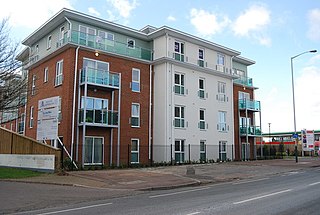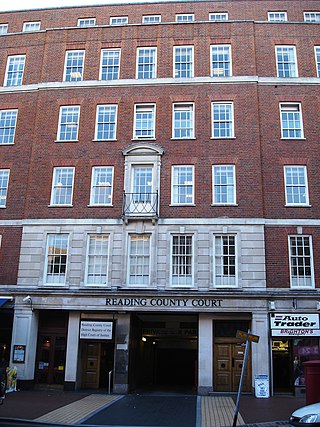
In Ireland and the United Kingdom, housing associations are private, non-profit making organisations that provide low-cost "social housing" for people in need of a home. Any budget surplus is used to maintain existing housing and to help finance new homes and it cannot be used for personal benefit of directors or shareholders. Although independent, they are regulated by the state and commonly receive public funding. They are now the United Kingdom's major providers of new housing for rent, while many also run shared ownership schemes to help those who cannot afford to buy a home outright.

A landlord is the owner of a house, apartment, condominium, land, or real estate which is rented or leased to an individual or business, who is called a tenant. When a juristic person is in this position, the term landlord is used. Other terms include lessor and owner. The term landlady may be used for the female owners. The manager of a pub in the United Kingdom, strictly speaking a licensed victualler, is referred to as the landlord/landlady. In political economy it refers to the owner of natural resources alone from which an economic rent, a form of passive income, is the income received.

Eviction is the removal of a tenant from rental property by the landlord. In some jurisdictions it may also involve the removal of persons from premises that were foreclosed by a mortgagee.

The Civil Rights Act of 1968 is a landmark law in the United States signed into law by United States President Lyndon B. Johnson during the King assassination riots.
Section 8 of the Housing Act of 1937, often called Section 8, as repeatedly amended, authorizes the payment of rental housing assistance to private landlords on behalf of low-income households in the United States. Fort Lauderdale, Florida Housing Authority Director William H. Lindsey, upon the advice of Housing Authority attorney J. Richard Smith, initially developed 11(b) financing in the early 1970s to accommodate a local savings and loan interested in assisting with urban renewal projects Lindsey eventually brought to fruition. This was the initial impetus for the subsequent development of the now well known Section 8 Program. 68% of total rental assistance in the United States goes to seniors, children, and those with disabilities. The U.S. Department of Housing and Urban Development manages Section 8 programs.
Subsidized housing is government sponsored economic assistance aimed towards alleviating housing costs and expenses for impoverished people with low to moderate incomes. In the United States, subsidized housing is often called "affordable housing". Forms of subsidies include direct housing subsidies, non-profit housing, public housing, rent supplements/vouchers, and some forms of co-operative and private sector housing. According to some sources, increasing access to housing may contribute to lower poverty rates.

A house in multiple occupation (HMO), or a house of multiple occupancy, is a British English term which refers to residential properties where ‘common areas’ exist and are shared by more than one household.
The assured shorthold tenancy (AST) is the default legal category of residential tenancy in England and Wales. It is a form of assured tenancy with limited security of tenure, which was introduced by the Housing Act 1988 and saw an important default provision and a widening of its definition made by the Housing Act 1996. Since 28 February 1997 in respect of accommodation to new tenants who are new to their landlords, the assured shorthold tenancy has become the most common form of arrangement that involves a private residential landlord. The equivalent in Scotland is short assured tenancy.
Under the provisions of the United Kingdom Housing Act 2004 every landlord or letting agent that takes a deposit for an assured shorthold tenancy in England and Wales must protect the deposit under an authorised tenancy deposit scheme. The regulations came into effect on 6 April 2007, and were amended by the Localism Act 2011 and the Deregulation Act 2015. Most recently the Tenant Fees Act 2019 provided further protections for tenants.

The Housing Act 2004 is an Act of the Parliament of the United Kingdom. It introduced Home Information Packs, which have since been abandoned. It also significantly extends the regulation of houses in multiple occupation by requiring some HMOs to be licensed by local authorities. Finally, it provides the legal framework for tenancy deposit schemes, which are intended to ensure good practice regarding deposits in assured shorthold tenancies and make dispute resolution relating to them easier.

An assured tenancy is a legal category of residential tenancy to an individual in English land law. Statute affords a tenant under an assured tenancy a degree of security of tenure. A tenant under an assured tenancy may not be evicted without a reasonable ground in the Housing Act 1988 and, where periodic changes in rent are potentially subject to a challenge before a rent assessment committee.
An emotional support animal (ESA) is an animal that provides relief to individuals with "psychiatric disability through companionship." Emotional support animals may be any type of pet, and are not recognized as service animals under the Americans with Disabilities Act.
A short assured tenancy is a type of tenancy in Scotland that was introduced by the Housing (Scotland) Act 1988. A short assured tenancy gives landlords some protection and freedom of action when letting their properties. Short assured tenancies have become the norm within the residential letting industry in Scotland. The equivalent legislation in England and Wales is assured shorthold tenancy. Following the enactment of the Private Housing (Tenancies) (Scotland) Act 2016, it is no longer possible to create a short assured tenancy, instead a private residential tenancy must be entered into; with greater protections for the tenant such as security of tenure.
The Scottish Housing Regulator (SHR) is an independent Non-Ministerial Department, directly accountable to the Scottish Parliament. The body was established on 1 April 2011 under the Housing (Scotland) Act 2010. SHR is the successor to the previous Scottish Housing Regulator agency, which exercised Scottish Ministers' powers under the Housing (Scotland) Act 2001.
Rent regulation is a system of laws, administered by a court or a public authority, which aims to ensure the affordability of housing and tenancies on the rental market for dwellings. Generally, a system of rent regulation involves:
Rent regulation in England and Wales is the part of English land law that creates rights and obligations for tenants and landlords. The main areas of regulation concern,
The Costa–Hawkins Rental Housing Act ("Costa–Hawkins") is a California state law, enacted in 1995, which places limits on municipal rent control ordinances. Costa–Hawkins preempts the field in two major ways. First, it prohibits cities from establishing rent control over certain kinds of residential units, e.g., single-family dwellings and condominiums, and newly constructed apartment units; these are deemed exempt. Second, it prohibits "vacancy control", also called "strict" rent control. The legislation was sponsored by Democratic Senator Jim Costa and Republican Assemblymember Phil Hawkins.

The Housing Act 1988 is an Act of Parliament in the United Kingdom. It governs the law between landlords and tenants. The Act introduced the concepts of assured tenancy and assured shorthold tenancy. It also facilitated the transfer of council housing to not-for-profit housing associations, which was then carried out partly through the system of Large Scale Voluntary Transfer.

The Housing and Planning Act 2016 is Act of Parliament in the United Kingdom that makes widespread changes to housing policy and the planning system. It introduces legislation to allow the sale of higher value local authority homes, introduce starter homes and "Pay to Stay" and other measures intended to promote home ownership and boost levels of housebuilding. The Act has been subject to a number of criticisms by those opposed to the loss of social housing promoted, the extension of right-to-buy to housing associations and possible work disincentives under "Pay to Stay".

Eviction in the United States refers to the pattern of tenant removal by landlords in the United States. In an eviction process, landlords forcibly remove tenants from their place of residence and reclaim the property. Landlords may decide to evict tenants who have failed to pay rent, violated lease terms, or possess an expired lease. Landlords may also choose not to renew a tenant's lease, however, this does not constitute an eviction. In the United States, eviction procedures, landlord rights, and tenant protections vary by state and locality. Historically, the United States has seen changes in domestic eviction rates during periods of major socio-political and economic turmoil—including the Great Depression, the 2008 Recession, and the COVID-19 pandemic. High eviction rates are driven by affordable housing shortages and rising housing costs. Across the United States, low-income and disadvantaged neighborhoods have disproportionately higher eviction rates. Certain demographics—including low income renters, Black and Hispanic renters, women, and people with children—are also at a greater risk of eviction. Additionally, eviction filings remain on renters' public records. This can make it more difficult for renters to access future housing, since most landlords will not rent to a tenant with a history of eviction. Eviction and housing instability are also linked to many negative health and life outcomes, including homelessness, poverty, and poor mental and physical health.








